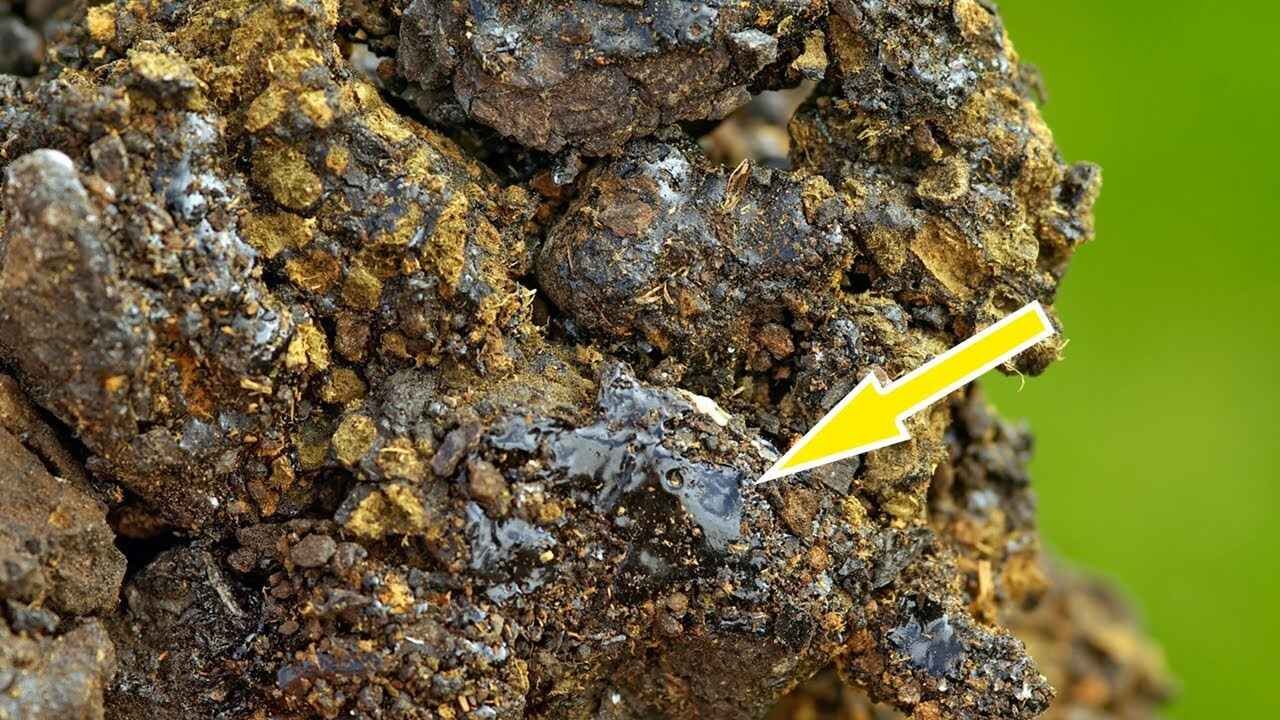What is Shilajit?
Shilajit, the purest form of itself, is a viscous, tar-like substance. It originates neither solely from plants nor animals but emerges as a mineral pitch naturally found in the Himalayan rocks situated at altitudes ranging from 1000 to 5000 meters above sea level.
Shilajit, which consists of humus and partly decomposed plant elements, is identified by multiple names. Its botanical label is Asphaltum, referred to as Black Bitumen or Mineral Pitch in English and recognized as Hajar-ul-Musa in Arab tradition.
Shilajit, loaded with over 85 minerals, including humic and fulvic acids, has been a cornerstone of Ayurvedic medicine for centuries. Known as the “Warrior of Strength” in Ayurveda, this revered herb mineral boasts potent attributes.
Fulvic acid, a key component of Shilajit, is a rich source of bioactive minerals, historically revered as a cure-all and deemed essential in treating various illnesses. Its use spans back 3000 years, deeply ingrained in Ayurvedic traditions.
Recognized for its rich nutrient profile, Shilajit is significant in traditional medicine and is renowned for boosting energy, mental function, and overall well-being. Athletes and bodybuilders favor it as a supplement to enhance stamina and physical prowess. While generally safe, caution is advised for pregnant or breastfeeding individuals and those taking specific medications due to potential interactions.
Beyond managing stress, Shilajit plays a pivotal role in addressing a spectrum of health issues, including dysuria, glycosuria, respiratory problems, urinary troubles, skin conditions, piles, kidney stones, epilepsy, mental health concerns, and anemia.
Where is Shilajit found, and how is it made edible?
Shilajit is collected in numerous places like Pakistan, Nepal, Afghanistan, China, Bhutan, India, Tibet, and some Caucasian regions, but the Himalayan highlands in Pakistan, which are between 10,000 and 12,000 feet above sea level, provide the highest concentration of genuine therapeutic components. People gather on the steep Himalayan rock walls, where organic materials collect within stone cracks and gaps. Over time, this viscous substance emerges and flows to the surface.
It presents as a bitter, dark brown to almost black substance renowned for enhancing the body’s overall effectiveness. This exudate seeps from the rocky layers of the mountains and is essentially composed of humus and organic plant matter compacted by mountain rock layers.
Given that our primary source of food is plants, humus stands as a crucial nourishing element for them. Within Shilajit, approximately 60% to 80% of the humus consists of organic matter.
The most authentic and superior quality of shilajit is sourced from these revered, immense mountains. As raw shilajit may harbor fungal toxins and free radicals, proper processing becomes essential. It involves eliminating polymeric quinone radicals, mycotoxins, toxins, and other ineffective components through the processing stages.
Shilajit’s Chemical Composition
The composition of shilajit is significantly influenced by factors like the plant species involved, the geological structure of the rocks, as well as local temperature, altitude, and humidity.
Typically, shilajit consists of 60 to 80 percent organic matter, around 20 to 40 percent mineral content, and about 5 percent trace elements. Among its components are fatty acids, benzoic acid, hippuric acid, resin, waxy substances, albuminoids, gums, vegetable matter, and approximately 80 bioactive ingredients.
The primary constituents of shilajit, forming a phyto-complex molecule, comprise humus elements such as humic acids and fulvic acid, accounting for 60–80% of its content.
Additionally, it contains triterpenes, sterols, ichthyol, ellagic acid, resin, aromatic carboxylic acids, 3,4-benzo-coumarin, amino acids, phenolic lipids, and an array of minerals, including selenium, iron, antimony, lithium, manganese, calcium, copper, and molybdenum.
Top 8 Health Benefits of Shilajit Resin
1. Improves Mental Skills
A study in the International Journal of Alzheimer’s Disease noted that shilajit is traditionally used for longevity and to slow aging. The compounds in it may help control cognitive disorders, such as Alzheimer’s.
Shilajit is known for boosting brain function. Bioactive compounds like dibenzo-alpha-pyrones aid in preserving brain chemicals crucial for memory, thereby improving attention, concentration, calmness, alertness, and overall memory retention.
Utilized in various forms, such as tablets or other formulations, Shilajit serves as a brain tonic and stimulant. It’s employed in treating conditions like Alzheimer’s disease and other psychotic disorders, effectively enhancing memory, reasoning, problem-solving skills, and diverse cognitive abilities in users.
Strong antidepressant properties of the herb also help with boosting energy and stamina, reducing all kinds of mental and physical stress, and calming the mind.
2. Protects Digestive Problems
Shilajit helps fight harmful stomach bacteria and reduces inflammation. It works as a strong remedy for constipation and piles by making it easier for stools to move through the body. It also prevents tummy troubles like colic, discomfort, and gas by keeping the colon healthy and hydrated.
3. Boosts Cardiac Function
As per the study, Shilajit boosts cardiac function and has been identified as the finest mineral-herb combination that is good for the heart.
It is essential in the treatment of many heart disorders due to its high antioxidant content and cardio-protective properties. People who have cardiac conditions like palpitations and arrhythmias might benefit greatly from it because it relaxes the heart while also calming the mind.
The risk of atherosclerosis, heart block, heart attacks, blood clots, and other illnesses can be reduced by strengthening the heart muscles, reducing blood cholesterol levels, and avoiding lipid accumulation.
4. Enhances Male Fertility and Testosterone
Shilajit provides a traditional solution to boost male fertility and libido. Its potent aphrodisiac qualities stimulate testosterone production, heightening both fertility and libido while easing mental stress and anxiety.
As a safe supplement, Shilajit aids male infertility. In a study, 60 infertile men took Shilajit twice daily, after meals, for 90 days. The results were promising—over 60% of the participants experienced a rise in their total sperm count, and more than 12% saw improved sperm movement. Sperm motility, a vital factor in fertility, increased significantly in those tested.
Another study explored Shilajit’s impact on testosterone levels in healthy volunteers aged 45 to 55. Over a 90-day period, these individuals taking shilajit showed noteworthy rises in their total testosterone levels, as observed by researchers.
Before going to bed, it has been demonstrated that consuming milk and pure shilajit resin increases genital blood flow, which enhances the production of testosterone and luteinizing hormone, which enhances the motility and quality of male sperm.
5. Anti-Aging
A study found that fulvic acid, one of the key ingredients in shilajit, has anti-inflammatory and antioxidant qualities. Therefore, it could help reduce the body’s levels of free radicals and cellular damage, two significant factors in aging.
Some people may age more slowly and feel more energized with daily shilajit supplements.
6. Preventing from cancer
Shilajit displays potential for combating specific cancer cell types. In a study, shilajit was observed to facilitate the elimination of cancer cells in the liver and prevent their multiplication.
Researchers highlighted the anti-cancer impact of shilajit in their findings, underscoring the need for further studies to delve deeper into its effects.
7. Obesity
Having excess weight can strain muscles and bones. A study in the Journal of Medicinal Food found that obese individuals taking purified shilajit as an oral supplement responded better to exercise compared to those who did not.
The research suggested that shilajit activated certain genes in the body, aiding skeletal muscles in adapting swiftly to the workout. This effect might lead to reduced fatigue and increased strength with continued exercise.
8. Anemia due to a lack of iron
Low iron intake, blood loss, or a problem absorbing iron can all lead to iron deficiency anemia. Here are several signs:






